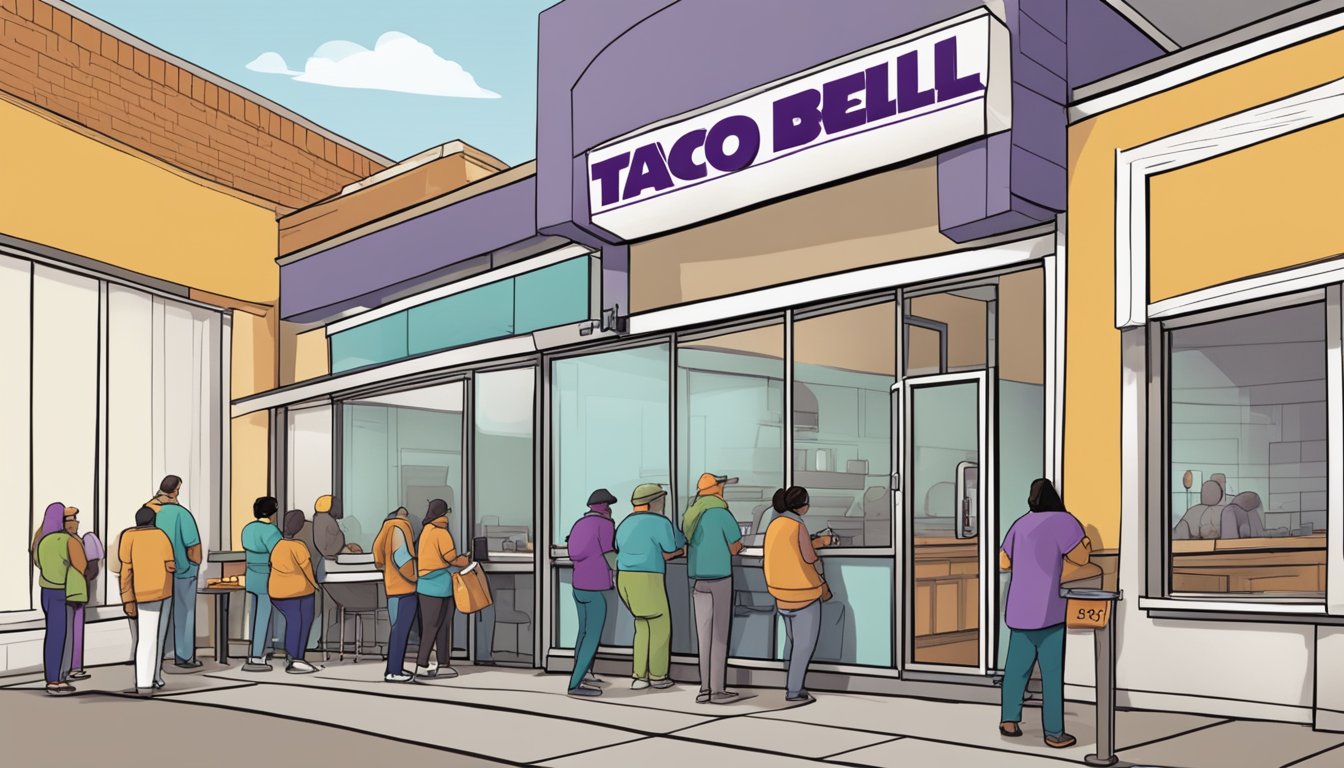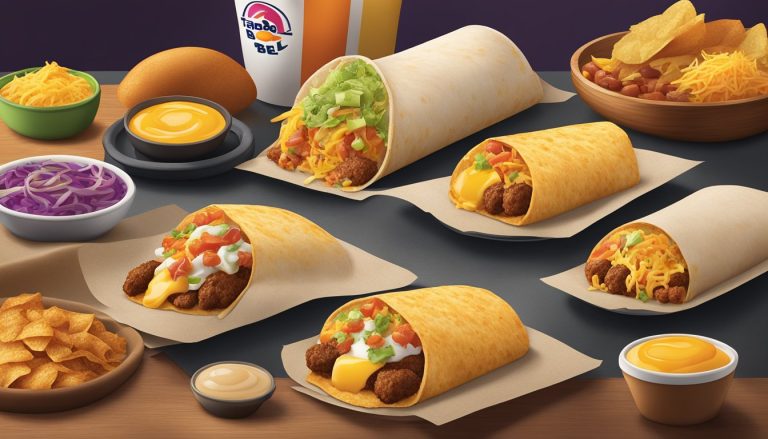Taco Bell’s entry into the breakfast market in 2014 marked a significant shift in the fast-food industry. The chain’s decision to offer breakfast items challenged established competitors like McDonald’s, long considered the king of fast-food breakfast. Taco Bell’s innovative approach to breakfast, featuring unique menu items like breakfast burritos and waffle tacos, disrupted the traditional fast-food breakfast landscape and forced competitors to reevaluate their offerings.
This move by Taco Bell was part of a larger trend among fast-food chains seeking to capitalize on the lucrative breakfast market. By expanding into this daypart, Taco Bell aimed to increase sales and attract new customers. The company’s aggressive marketing campaign, which directly targeted McDonald’s, generated buzz and drew attention to their new breakfast menu.
The introduction of Taco Bell’s breakfast menu had ripple effects throughout the industry. Competitors responded by updating their own breakfast offerings and adjusting pricing strategies. This intensified competition benefited consumers, who gained more breakfast options and potentially better value. The breakfast battle initiated by Taco Bell continues to shape the fast-food landscape, influencing menu innovations and marketing strategies across the industry.
The Evolution of Taco Bell’s Breakfast

Taco Bell’s entry into the breakfast market marked a significant shift in fast-food morning offerings. The chain’s approach combined innovative products with strategic expansion to carve out a unique niche.
Launch and Expansion
Taco Bell introduced its breakfast menu nationwide on March 27, 2014. This launch represented the culmination of two years of testing and development. The company rolled out breakfast options to all 5,500 U.S. locations simultaneously.
The expansion was supported by Taco Bell’s largest marketing campaign to date. This aggressive approach aimed to quickly establish the brand as a serious contender in the breakfast market.
Taco Bell’s breakfast hours typically run from 6 a.m. to 11 a.m., aligning with industry standards. The chain’s decision to enter the breakfast space challenged established players like McDonald’s and Burger King.
Product Innovation and Differentiation
Taco Bell’s breakfast menu stood out with its unique offerings. The Waffle Taco, featuring a folded waffle filled with eggs and sausage, became an early signature item.
Other innovative products included:
- Breakfast Crunchwrap: A hexagonal wrap with eggs, cheese, and meat
- A.M. Grilled Taco: A flour tortilla filled with eggs and cheese
- Cinnabon Delights: Bite-sized pastries filled with frosting
The chain also adapted existing favorites for breakfast, like the Breakfast Burrito. Taco Bell’s strategy focused on portability and bold flavors, distinguishing it from traditional breakfast fare.
Product innovation remained a key focus. The menu evolved to include items like the Grande Scrambler and Breakfast Quesalupas, maintaining customer interest and media attention.
Analyzing the Breakfast Market

The breakfast market presents a significant opportunity for fast-food chains. Taco Bell’s entry into this space has shifted competitive dynamics and consumer behavior.
Taco Bell’s Position in the Market
Taco Bell, owned by Yum! Brands, entered the breakfast market in 2014. This move allowed the chain to utilize its facilities before 10 am, previously idle during morning hours. Taco Bell differentiated itself with Mexican-inspired breakfast items, aiming to appeal to younger consumers seeking alternatives to traditional offerings.
The chain’s breakfast menu includes unique items like the Breakfast Crunchwrap and Cinnabon Delights. This strategy positions Taco Bell as an innovative player in the breakfast segment, challenging established competitors.
Taco Bell’s breakfast launch required substantial marketing investments to build awareness and drive trial. The company leveraged its existing brand equity and youthful image to attract customers.
Consumer Behavior and Preferences
Breakfast consumers often prioritize convenience, speed, and portability. Many seek options that can be easily consumed on-the-go during busy mornings.
Health consciousness is a growing trend, with some consumers looking for nutritious breakfast choices. This has led to increased demand for items like yogurt parfaits and fruit options.
Price sensitivity varies among breakfast consumers. Some prioritize value deals, while others are willing to pay premium prices for perceived quality or unique offerings.
Taste preferences for breakfast tend to be more traditional, with familiar flavors like eggs, bacon, and coffee remaining popular. However, there’s a growing openness to new and diverse breakfast options.
Competitor Analysis
McDonald’s dominates the fast-food breakfast market with its long-established menu items like the Egg McMuffin. The chain has expanded its breakfast offerings and extended breakfast hours to maintain its leading position.
Starbucks is a major player, focusing on coffee-based beverages and complementary food items. Its loyalty program and mobile ordering capabilities give it a competitive edge.
Other quick-service restaurants like Burger King and Wendy’s have also expanded their breakfast menus to capture market share. These chains often compete on price and promotional offers.
Regional players and local cafes contribute to market fragmentation, offering unique breakfast options that cater to local tastes and preferences.
Strategic Marketing Tactics
Taco Bell employed targeted advertising and promotional strategies to drive awareness and trial of its breakfast offerings. The chain focused on differentiating itself from traditional fast food breakfast options.
Advertising Campaigns
Taco Bell launched bold, attention-grabbing ad campaigns to introduce its breakfast menu. TV commercials featured unexpected breakfast items like the Waffle Taco and A.M. Crunchwrap. Social media played a key role, with the brand leveraging platforms like Twitter and Instagram to generate buzz. Taco Bell created humorous content poking fun at conventional breakfast choices.
Digital marketing efforts included targeted ads on mobile apps and websites frequented by younger consumers. The chain also utilized influencer partnerships to reach millennial and Gen Z audiences. Outdoor advertising in high-traffic areas reinforced the message that Taco Bell was now a breakfast destination.
Promotional Strategies
Free giveaways were a core tactic to drive trial of new breakfast items. Taco Bell offered complimentary breakfast menu items on select days to entice customers. The chain implemented a rewards program with bonus points for breakfast purchases. This incentivized repeat visits during morning hours.
Limited-time offers created urgency and excitement around breakfast launches. Taco Bell introduced seasonal items like the Cinnabon Delights Coffee to keep the menu fresh. Competitive pricing was crucial, with many breakfast combos priced under $5 to undercut rivals. Convenient ordering via mobile app and drive-thru was emphasized to appeal to time-pressed morning customers.
Operational Excellence
Taco Bell’s breakfast initiative drove improvements in service delivery and expanded operating hours. These changes had ripple effects across the fast food industry, pushing competitors to enhance their own operational practices.
Efficiency in Service Delivery
Taco Bell optimized its kitchen workflows to accommodate breakfast items without disrupting existing operations. New equipment like high-speed toasters allowed for quick preparation of breakfast sandwiches. The chain streamlined its ordering process, introducing combo meals and simplified menu boards to reduce decision time for bleary-eyed morning customers.
Drive-thru lanes received particular attention. Taco Bell added dedicated breakfast lanes at some locations and retrained staff on rapid order fulfillment. These changes cut average drive-thru times by 17 seconds during breakfast hours.
Extended Breakfast Hours
Taco Bell’s decision to serve breakfast until 11 AM put pressure on competitors to extend their own hours. McDonald’s responded by offering all-day breakfast at many locations. Other chains like Burger King pushed back their breakfast cut-off times.
This shift required adjustments to staffing and food prep schedules. Chains had to balance the costs of longer operating hours against potential sales gains. Some locations opted for a limited all-day breakfast menu to simplify operations.
The extended hours also impacted delivery services, with more chains offering morning delivery options to compete with Taco Bell’s partnership with GrubHub for breakfast delivery.
Economic Impact on Competitor Chains

Taco Bell’s entry into the breakfast market created ripple effects across the fast-food industry. Established players faced new challenges as the competitive landscape shifted.
Market Share Shifts
Taco Bell’s breakfast launch led to noticeable changes in market share distribution. McDonald’s, long dominant in fast-food breakfast, saw its morning sales dip by 3.5% in the first year after Taco Bell’s entry. Other chains like Burger King and Wendy’s experienced smaller but significant declines of 1.8% and 2.1% respectively.
Taco Bell captured approximately 7% of the fast-food breakfast market within 18 months. This growth came primarily at the expense of established players. Smaller regional chains felt the squeeze as well, with some reporting up to 5% drops in breakfast revenue.
Competitive Pressure and Responses
Taco Bell’s breakfast menu forced competitors to innovate and adjust pricing strategies. McDonald’s introduced all-day breakfast to defend its market position. This move boosted McDonald’s overall sales by 5.7% but increased operational complexities.
Burger King rolled out new breakfast items and launched aggressive promotions. Their “2 for $4” breakfast deal aimed to compete directly with Taco Bell’s value offerings. Wendy’s expanded their breakfast hours and menu options in response to the shifting competitive landscape.
Smaller chains faced tough choices. Some opted to exit the breakfast segment entirely, while others doubled down with unique offerings to differentiate themselves. Jack in the Box, for instance, introduced a “Brunchfast” menu to carve out a niche between breakfast and lunch.
SWOT Analysis of Taco Bell’s Breakfast Rollout

Taco Bell’s entry into the breakfast market presented both opportunities and challenges. The company leveraged its strengths while facing potential weaknesses in this new venture.
Strengths and Opportunities
Taco Bell’s brand recognition and extensive restaurant network provided a solid foundation for its breakfast rollout. The chain’s reputation for innovative, Mexican-inspired offerings allowed it to differentiate its breakfast menu from competitors.
Market research indicated growing consumer demand for diverse breakfast options. Taco Bell capitalized on this trend by introducing unique items like the Waffle Taco and A.M. Crunchwrap.
The breakfast expansion created new revenue streams and increased store utilization during previously underutilized morning hours. This move helped Taco Bell compete directly with established breakfast players like McDonald’s and Burger King.
Weaknesses and Threats
Taco Bell faced operational challenges in implementing breakfast service across its locations. Training staff and ensuring consistent quality during a new daypart required significant investment and effort.
The company’s lack of experience in the breakfast segment posed a potential weakness. Established competitors had years of menu refinement and consumer loyalty in the morning market.
Changing consumer breakfast habits and health trends threatened Taco Bell’s high-calorie offerings. The chain needed to balance its indulgent image with growing demand for healthier options.
Intense competition in the fast-food breakfast space risked market saturation and reduced profit margins. Taco Bell had to continuously innovate to maintain its competitive edge and avoid menu fatigue.
The Future of Breakfast at Taco Bell
Taco Bell’s breakfast offerings are poised for continued growth and innovation. The chain’s unique approach to morning meals has carved out a distinct niche in the competitive fast-food breakfast market.
Potential for Innovation and Expansion
Taco Bell’s breakfast menu is likely to see further expansion and creative twists on traditional morning fare. The chain may introduce more portable options to cater to on-the-go customers. New flavor combinations and ingredients could be incorporated to keep the menu fresh and exciting.
Collaborations with popular brands or limited-time offers may help generate buzz and attract new customers. Taco Bell might also explore healthier breakfast alternatives to appeal to health-conscious consumers.
The company could leverage technology to enhance the breakfast experience. Mobile ordering and customization options may become more sophisticated, allowing customers to tailor their morning meals with ease.
Forecasting Sales and Market Trends
Taco Bell’s breakfast sales are expected to show steady growth in the coming years. The chain’s ability to attract younger demographics with its innovative menu items gives it a competitive edge.
Market research will play a crucial role in shaping future breakfast strategies. Taco Bell may conduct extensive surveys and taste tests to gauge customer preferences and identify emerging trends.
As more people return to offices and daily commutes, the demand for convenient breakfast options is likely to increase. Taco Bell could capitalize on this by optimizing its drive-thru and delivery services for morning rush hours.
The chain might also explore expanding breakfast hours to capture late-morning or all-day breakfast customers, potentially boosting overall sales figures.




